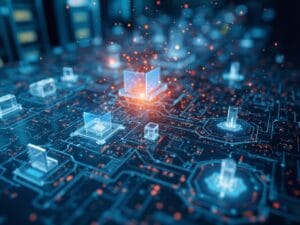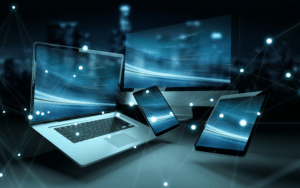Cloud-based SaaS IT solutions have transformed how businesses operate, offering advanced applications that cut costs and boost efficiency. Industry data projects SaaS will power 85% of business software by 2025, with global spending set to hit $232 billion in 2024 as companies shift their operations to cloud platforms.
Key Takeaways:
- SaaS platforms deliver shared architecture, seamless updates, and flexible subscription pricing, making them cost-effective and scalable for businesses of all sizes
- Companies can slash IT costs by 30-40% with SaaS implementation while getting faster deployment and improved remote work capabilities
- Built-in security measures like end-to-end encryption, multi-factor authentication, and continuous backups keep business data secure
- Smooth integration with CRM, ERP, and HR platforms creates efficient data flow between systems, cutting manual data entry and admin time by up to 60%
- Innovation in AI, IoT, and edge computing continues shaping SaaS development, enabling smarter automation and instant data analysis
The Evolution and Impact of SaaS Solutions
From Past to Present: SaaS Growth
Software as a Service (SaaS) has revolutionized how businesses access and use software applications since the 1990s. Starting as basic email and collaboration tools, SaaS has grown into sophisticated applications that power modern business operations. Tech giants like IBM, Microsoft, Google, and Salesforce lead this transformation through cloud-based delivery models.
Today’s SaaS platforms share these key features:
- Multi-tenant architecture letting multiple users access the same software
- Automatic updates eliminating manual maintenance
- Subscription-based pricing reducing upfront costs
- Browser-based access enabling remote work
- Scalable resources matching business growth
According to Gartner research, SaaS will account for 85% of business software use by 2025. This shift reflects the clear advantages of cloud-based solutions over traditional software installations. I’ve seen firsthand how SaaS tools boost productivity while cutting IT costs across organizations of all sizes.
Market Growth and Financial Projections
Current Market Dynamics
The SaaS spending shows remarkable momentum, with Gartner predicting $232 billion in global expenditure for 2024, marking a 17.7% increase from previous years. I’ve noticed businesses rapidly shifting to cloud-based solutions, with 70% of applications now running on SaaS platforms.
Financial Outlook
The market’s financial trajectory points up, with projections reaching $344 billion by 2027. This steady 7.89% annual growth stems from two key factors: freemium model popularity and major cloud providers’ market control. Amazon AWS, Microsoft Azure, and Google Cloud Platform lead the charge, shaping pricing structures and service delivery methods. Small businesses find the freemium model particularly attractive, as it offers basic features without upfront costs while providing clear upgrade paths for scaling operations.
Core Benefits and Implementation Challenges
Essential Advantages
SaaS solutions deliver substantial cost savings through predictable monthly subscriptions instead of hefty upfront investments. I’ve seen businesses cut IT expenses by 30-40% after switching to SaaS models. Quick deployment stands out as a major benefit – you can roll out solutions across multiple locations within days rather than months.
Remote work capabilities make SaaS particularly valuable, letting teams access tools from any device or location. Here are the key implementation factors to consider:
- Security measures often exceed in-house capabilities, with providers investing millions in data protection
- Service reliability depends on internet connectivity and provider uptime
- Data compliance requires careful vendor assessment, especially for regulated industries
- Legacy system integration needs thorough compatibility testing before deployment
While these platforms offer clear advantages, careful planning around system integration and compliance requirements remains crucial for successful implementation.
Technical Infrastructure and Security Framework
Cloud Architecture and Security Protocols
Modern SaaS solutions depend on advanced cloud delivery models that support seamless API integrations across multiple platforms. I recommend implementing Identity and Access Management (IAM) systems to control user permissions and data access effectively.
Your security strategy should incorporate these essential components:
- End-to-end encryption for data in transit and at rest
- Multi-factor authentication protocols
- Role-based access controls
- Regular security audits and vulnerability assessments
- Automated backup systems with disaster recovery
Meeting compliance standards forms a critical part of the security framework. GDPR demands strict data protection measures, while HIPAA requires specific security controls for healthcare information. Service Level Agreements (SLAs) should guarantee 99.9% uptime, define incident response times, and specify data recovery parameters. These agreements establish clear expectations for system performance and security maintenance.
Integration Capabilities with Business Systems
Core Business System Integration
Modern SaaS IT solutions connect directly with essential business platforms. I’ve found that CRM platforms like Salesforce and HubSpot form the backbone of customer data management, while ERP systems maintain operational flow. These integrations let you access critical data from a single dashboard, cutting down on manual entry and errors.
Workforce Management Tools
Your HR operations benefit from smart integration options. Here are the key integration points that boost efficiency:
- QuickPunch and AttendanceBot sync with existing HR systems for accurate time tracking
- Payroll systems pull attendance data automatically to calculate compensation
- Microsoft Teams connects with these tools for real-time updates
- Data flows between platforms through secure synchronization protocols
The connection between these systems creates a smooth data exchange. For example, when an employee clocks in through QuickPunch, the information updates across HR databases, payroll systems, and management dashboards instantly. This setup eliminates double entries and reduces administrative time by up to 60%. Each integration point strengthens your operational framework while maintaining data accuracy across all connected platforms.
Future Trends and Technologies
AI and Cloud Integration
AI has reshaped SaaS solutions through smart automation and data processing. Public cloud services join with hybrid models to create flexible infrastructure options. Edge computing brings processing closer to data sources, cutting response times and boosting efficiency.
Mobile and IoT Development
Mobile-first strategies dominate modern SaaS development, prioritizing responsive design and seamless user experiences across devices. The following advances shape current SaaS solutions:
- IoT sensors and devices that feed real-time data into SaaS platforms
- Advanced processing systems that handle massive data streams instantly
- Smart automation tools that reduce manual tasks
- Cross-platform compatibility for unified experiences
- Edge computing nodes that speed up local processing
These technologies create smarter, faster, and more connected SaaS solutions. By combining AI, cloud services, and IoT capabilities, businesses can automate complex processes and make better decisions through real-time insights.

Sources:
A3Logics – Questions to Ask from SaaS Providers
Forbes – 20 Questions to Ask a SaaS Vendor and What the Answers Should Be
Salesforce
IBM
Microsoft
Google
HubSpot
QuickPunch
AttendanceBot
Microsoft Teams
Related Posts

What is DRaaS? Understanding Disaster Recovery as a Service
Disaster Recovery as a Service (DRaaS) delivers cloud-based data protection through continuous server replication and automated recovery. This approach converts disaster recovery from a capital

Mobile Device Management: Enhancing Security and Productivity
Mobile Device Management: Enhancing Security and Productivity Mobile device management (MDM) is a crucial aspect of modern business operations. MDM allows organizations to efficiently manage, secure,

The Importance of IT Training for Your Staff: Enhancing Skills and Efficiency
IT training boosts employee productivity by 40% while strengthening staff retention and customer satisfaction. Skilled employees handle complex tasks independently, which cuts support costs and
